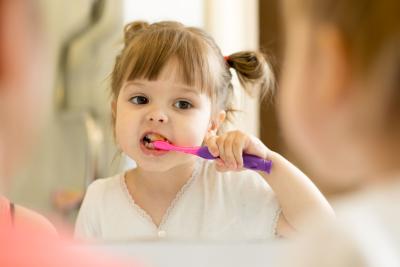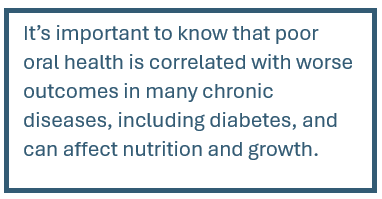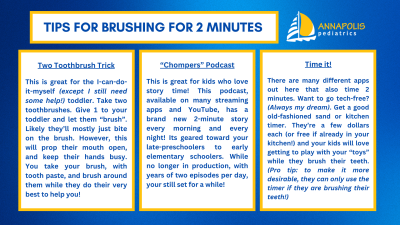Early Dental Care

Did you know cavities (also called caries) are the most common chronic disease of childhood? Almost 60% of teens have had at least one cavity, and 10% of teens currently have an untreated cavity! By late adulthood, almost every person has had a cavity – 96% of 65-year-olds! Our teeth need our help to stay healthy.
The good news is… cavities are almost completely preventable! 
Keep reading for more on how cavities form in children, what we can do to help prevent them, and when your child should start to receive dental care.
How do cavities form?
Cavities are an infectious disease that form after our mouths become home to cavity-causing bacteria. We are not born with these bacteria but rather we get it from those around us. So, cavities are actually an infectious disease.
These cavity-causing bacteria break down sugars – which are in nearly everything we eat – and create acid.
The acid dissolves the mineral content, also called enamel, of our teeth and over time this results in a cavity – literally a hole in the tooth!
Why do cavities matter?
If cavities develop and are untreated, they can lead to painful and severe infections including abscesses (deep tooth infections), infections of the face, systemic and blood stream infections and worse. Sometimes entire teeth need to be removed because the damage to the tooth is not fixable. That little hole can cause big problems.
When cavities are present, they can cause pain, affect speech, nutrition, play and learning. And, they can damage the underlying adult teeth waiting to come through.
How can we prevent cavities?
- Avoid sharing utensils, food, pacifiers, straws and cups. We as parents and caregivers already have cavity-causing bacteria in our mouths, but our children do not. By avoiding sharing things that touch our mouth we slow the movement of bacteria (and other viruses and infections!) into our children’s mouths. Sometimes your child really only wants the food you have – that’s ok. Plate the food on your plate, and before you start eating, with a clean utensil, push some of the food to the side, and then move it to your child’s plate with their own, clean, utensil.
- Brush teeth TWO TIMES A DAY with fluoride toothpaste. None of that “training toothpaste” without fluoride. We as parents are the trainers here, but we need the real toothpaste. Brushing gets that sugar off those teeth. If the sugar’s not there, the cavity can’t form! And fluoride (more below!) helps keep that outer enamel strong. For kids under an amount of toothpaste just visible on the brush (about the size of a grain of rice, or ¼ of a pea). Once they turn 3 years old, you can bump up to the full pea-sized amount of fluoride toothpaste. You’ll want to back up brush and supervise your child until they are around 8 years old – but some children need back up brushing for longer! And remember, once most of those teeth are in you’ll be brushing for2 MINUTES each time!

- Floss between any teeth that touch. Try the dental floss sticks or picks – they make it much easier to floss even the youngest teeth.
- Use fluoride. Fluoride prevents cavities by rebuilding and strengthening that outer layer of the tooth, also called enamel. Some communities have fluoride in their water, but not all do. And, if you are on well water, you likely do not have fluoride in your drinking water. That’s ok! You should also always use a fluoride toothpaste, no matter the age of your child (see #2). And fluoride can be applied as a fluoride varnish (available at your pediatric dentist, and coming soon to Annapolis Pediatrics!), which is shown to reduce the rate of cavities by 1/3!
- See the dentist early (between 12 and 18 months!) and regularly (every 3-6 months!). Your child should start seeing the dentist at their first birthday, or within 6 months of when their first teeth come in – whichever happens FIRST. Then your child should continue to see the dentist every 3-6 months, based on your dentists’ recommendations. Seeing the dentist regularly allows for thorough tooth inspections, deep tooth cleaning, targeted advice to maintain your child’s oral health based on their own tooth alignment, fluoride applications, sealant (prevents cavities in the back teeth), and if needed treatment of any cavities. Unfortunately, we as pediatric health care providers have all had too many children whose parents were told by their dentist that their children didn’t need to be seen until they were 3 years old – and we’ve seen too many children who’ve needed to get anesthesia and go to the operating room to have cavities filled and teeth pulled before they start elementary school. Having your child’s first dental visit between 12 and 18 months of age is important.
- Limit excessive snacking. We recommend that young children generally need 3 meals and 2 snacks per day. Children who snack all day have food in their mouth all day. Remember, almost everything we eat has some type of sugar in it. The more that sugar is there, the higher the risk of cavities.
Limit high sugar and acidic foods. This makes good health sense overall, but especially for our teeth. Snacks like raw veggies, fresh fruit, cheese, and water to drink are much better for our teeth (and our health overall!) compared to candy (sugar), crackers/bread (carbohydrates are sugars), dried fruit or processed fruit snacks (high in sugar, and sticky to the teeth), and juice, soda or sports drinks (which are often already acidic, and have lots of sugar).
Did you know pediatric dentists can put a pause on cavities in “baby” teeth?
If a cavity is detected early in a baby tooth, at one of your frequent (at least every 6 months!) dental visits, a pediatric dentist may be able to apply a compound called silver diamine fluoride. While this compound does stain the affected area black, it quickly and painlessly halts further development of the cavity in the baby tooth. It’s a huge advancement in dental care for kids.
Resources:
https://www.aapd.org/resources/parent/
